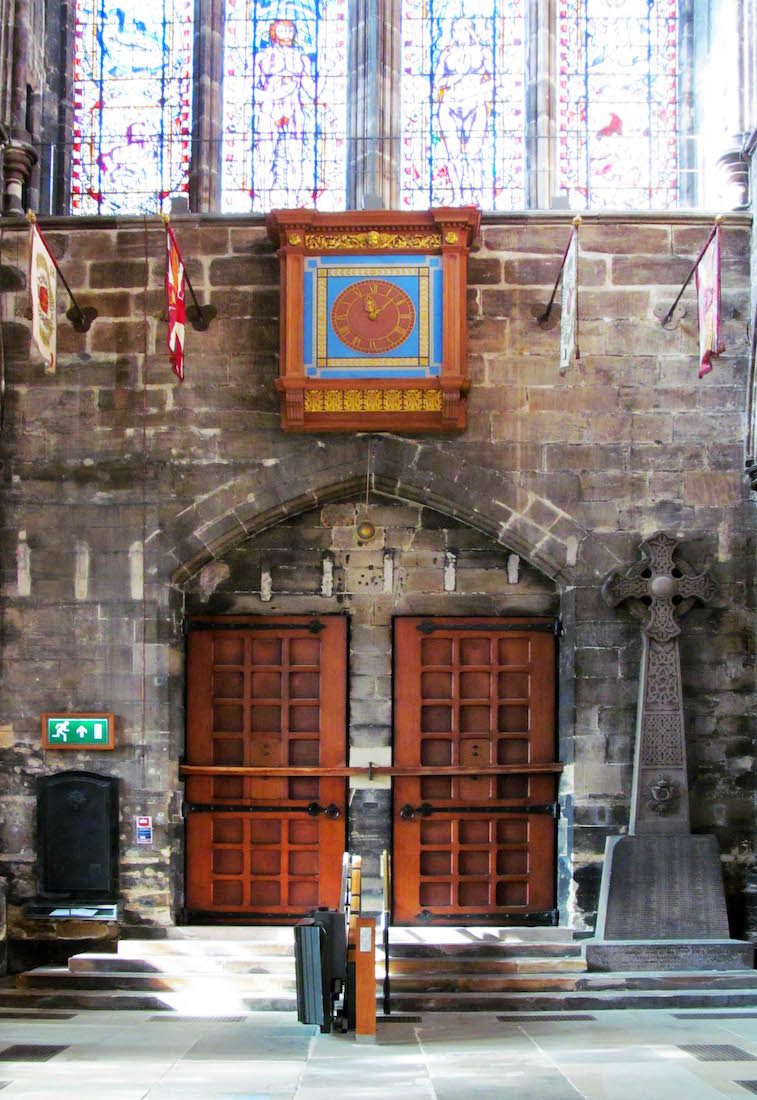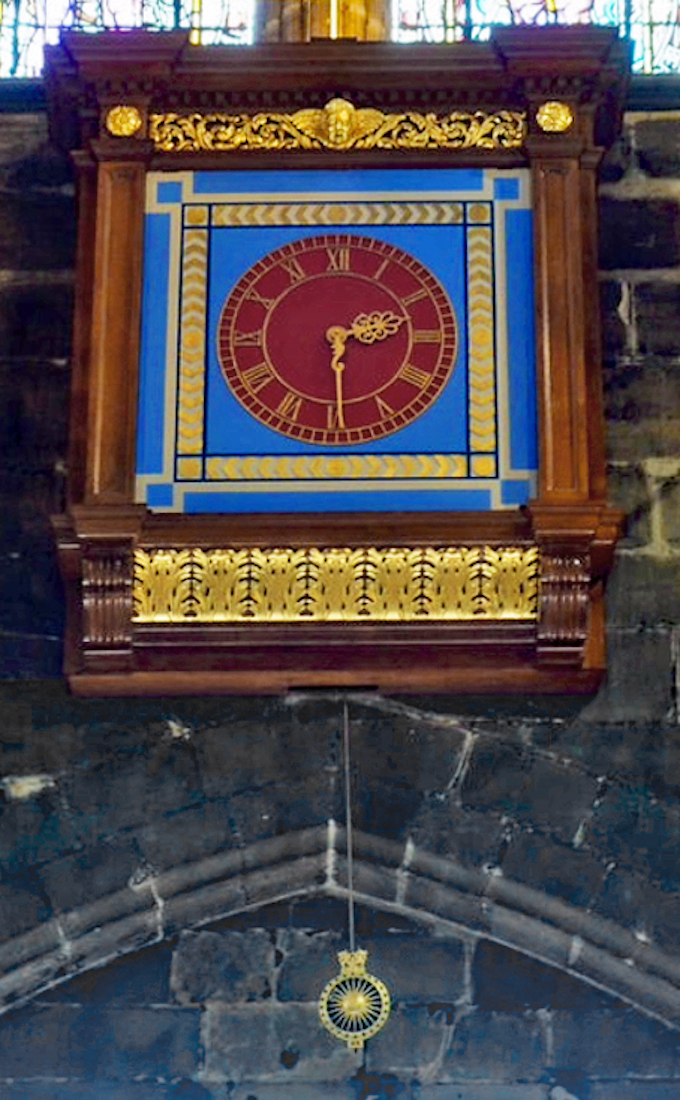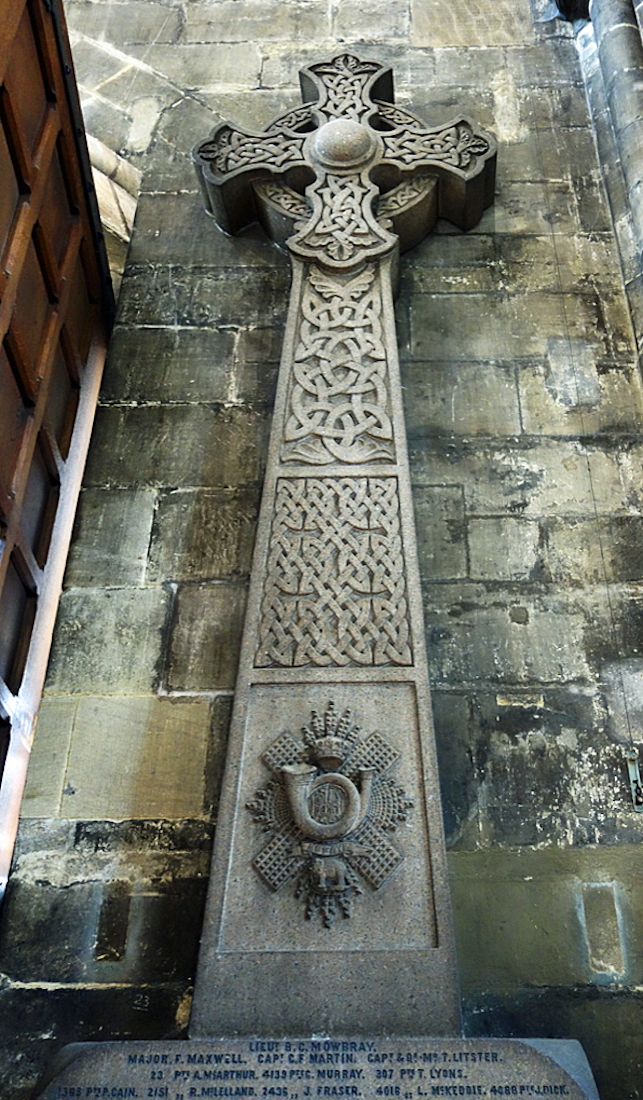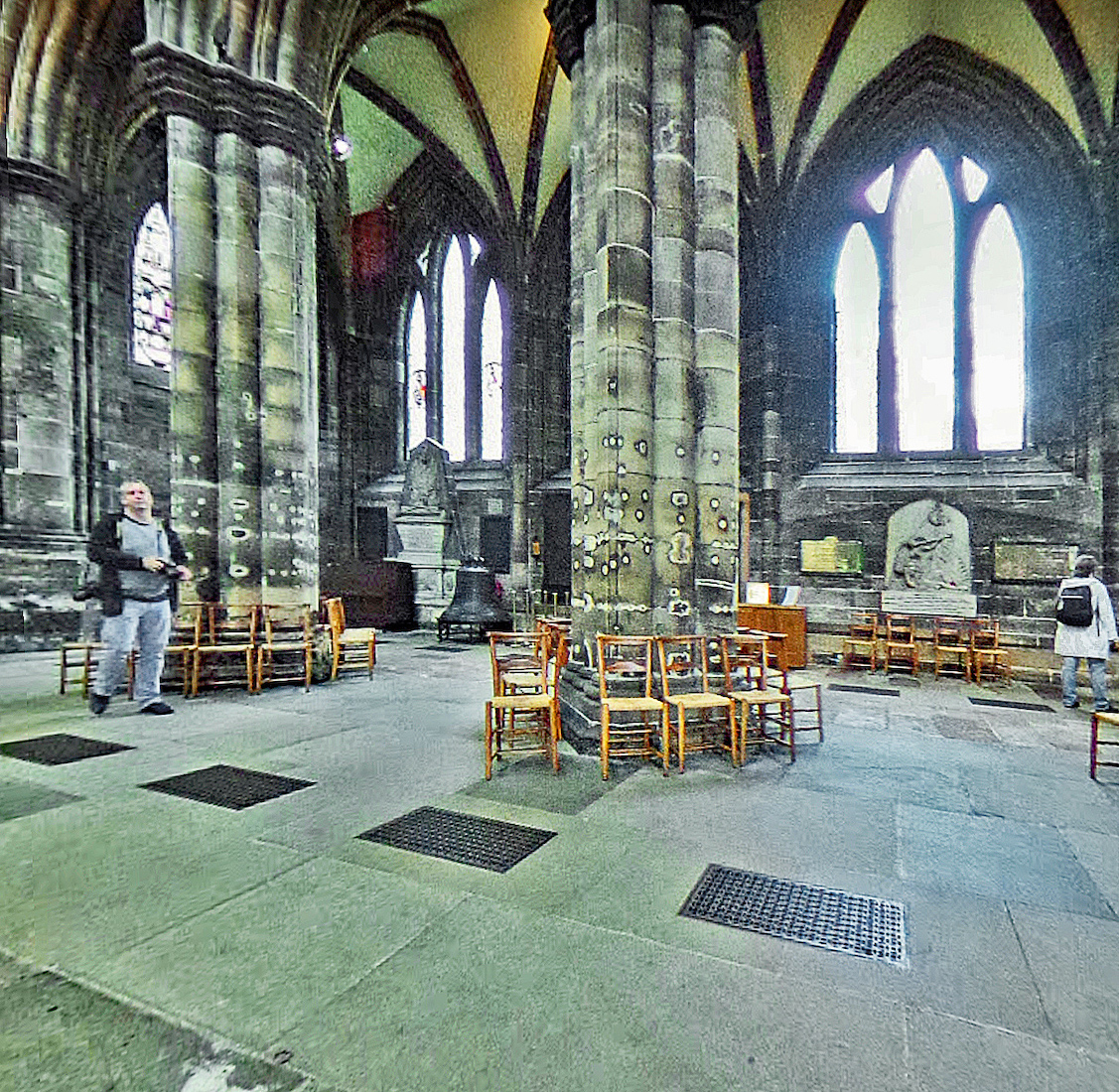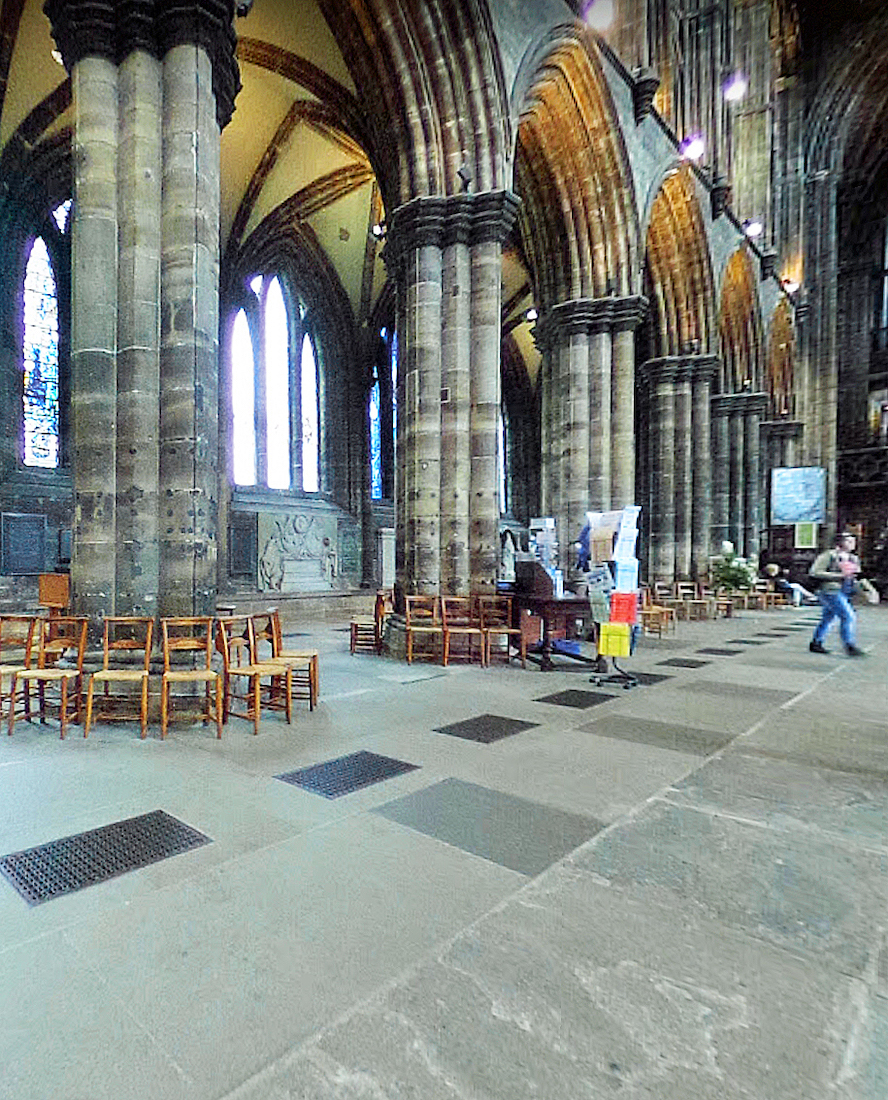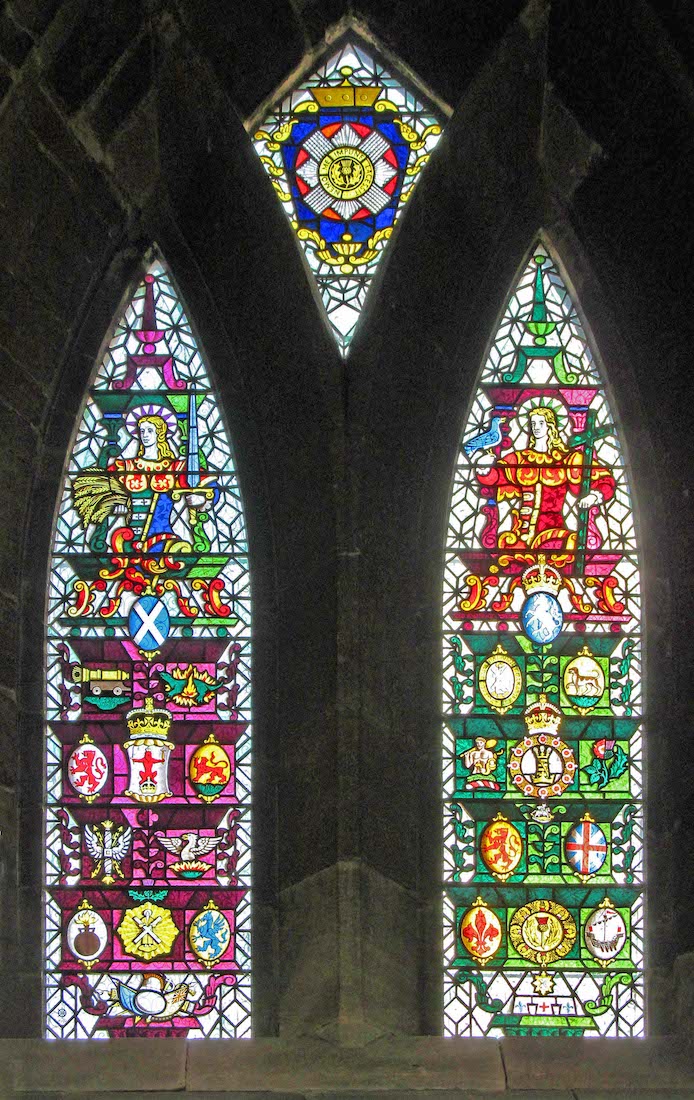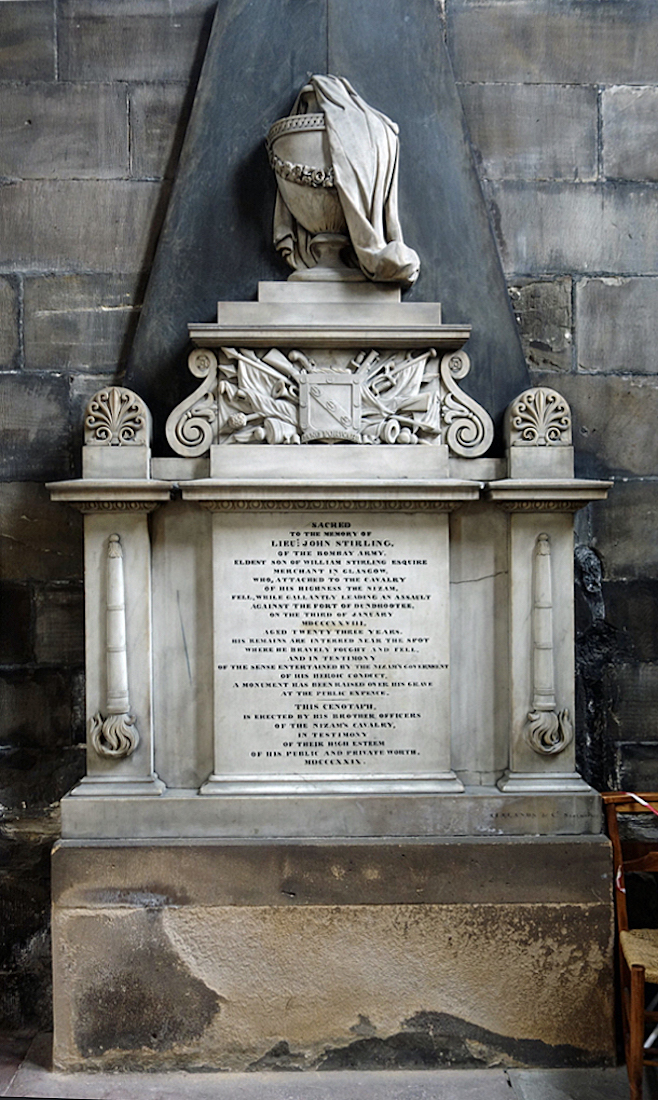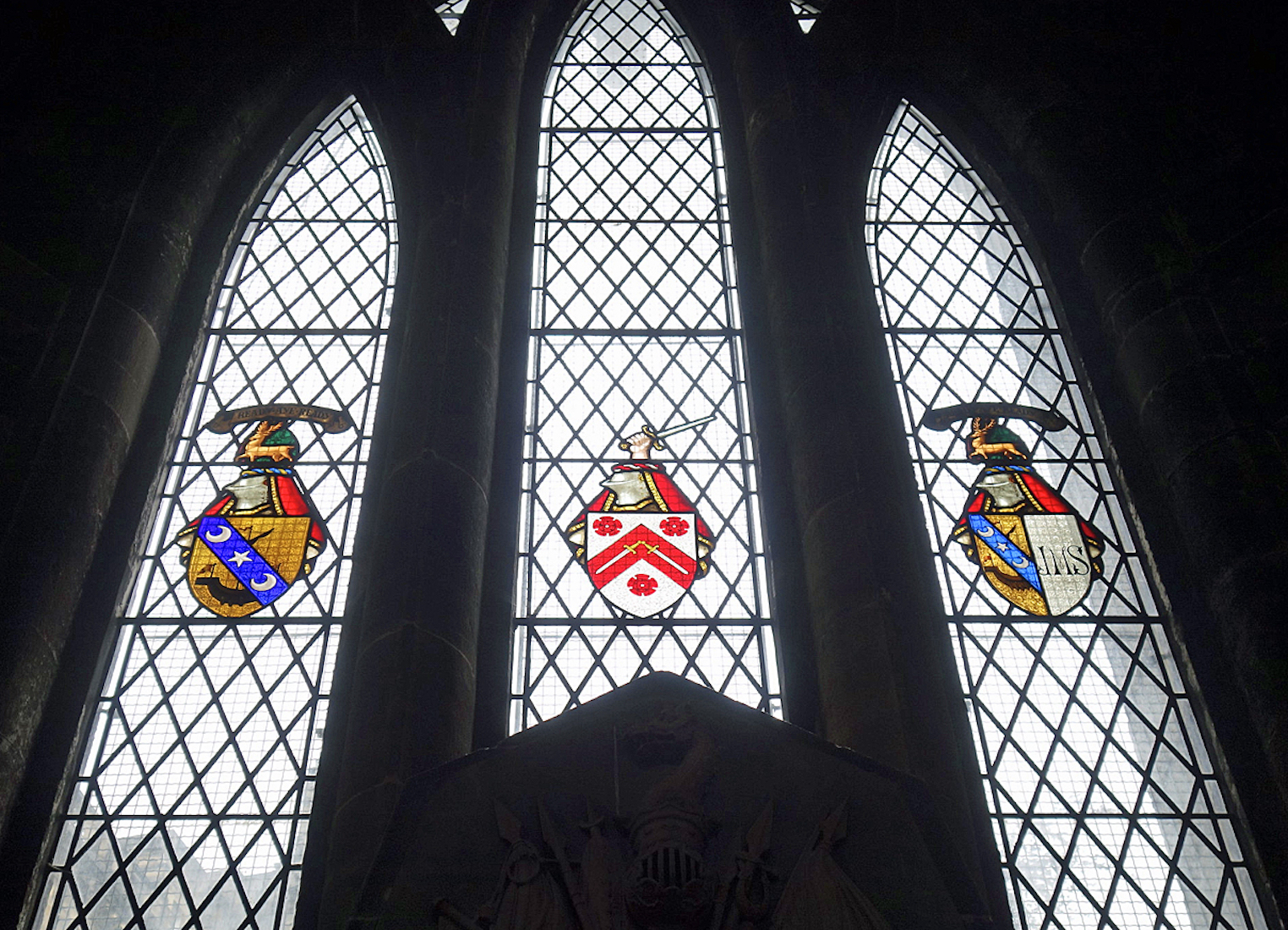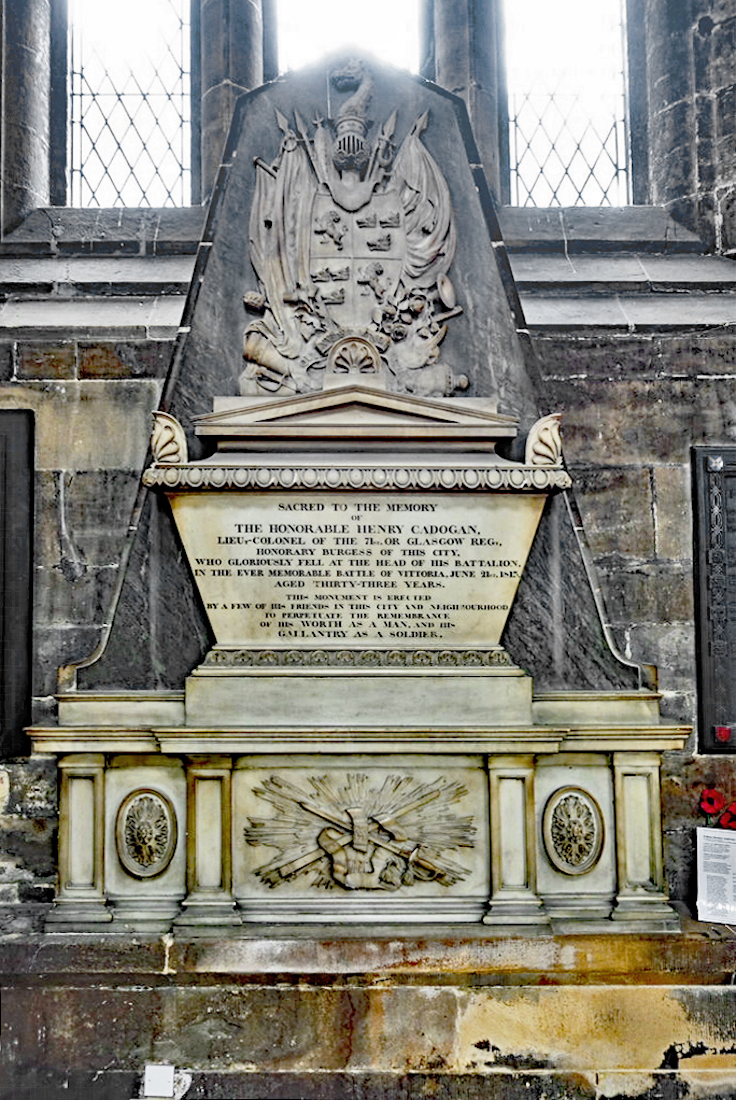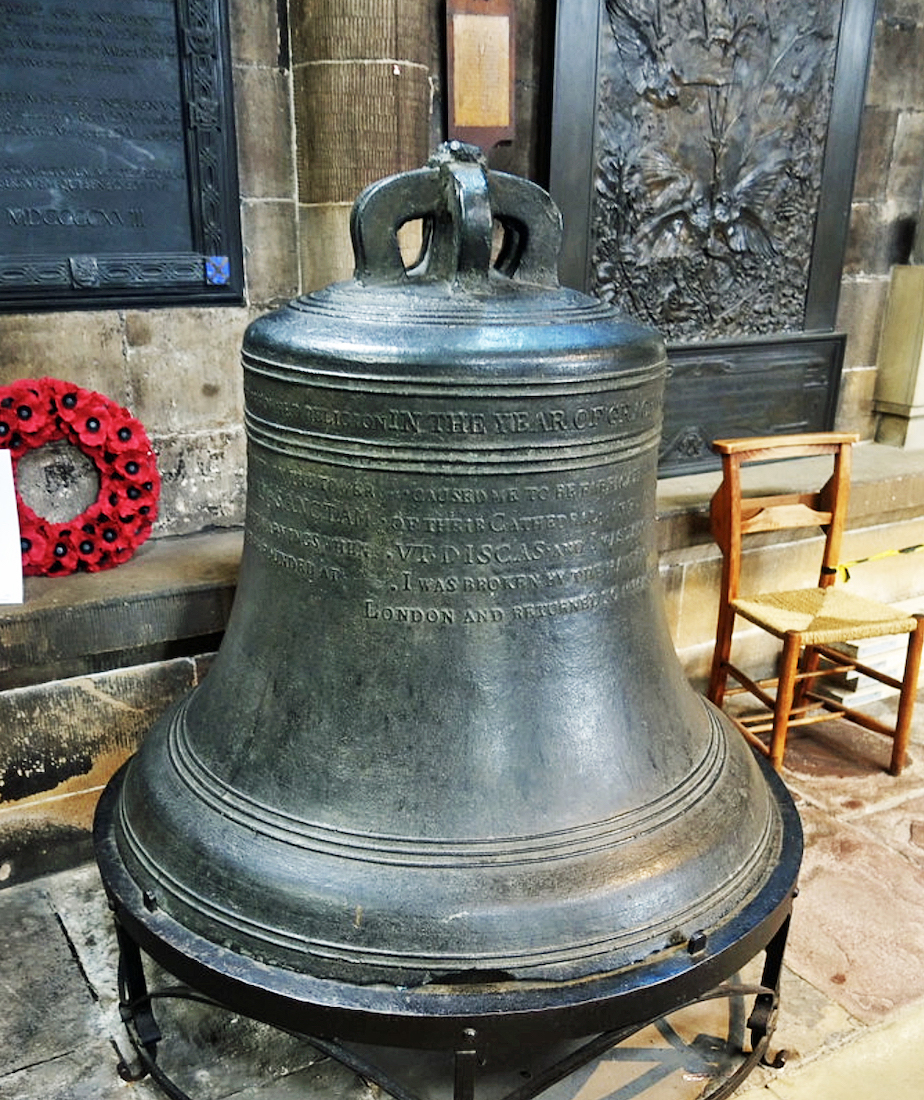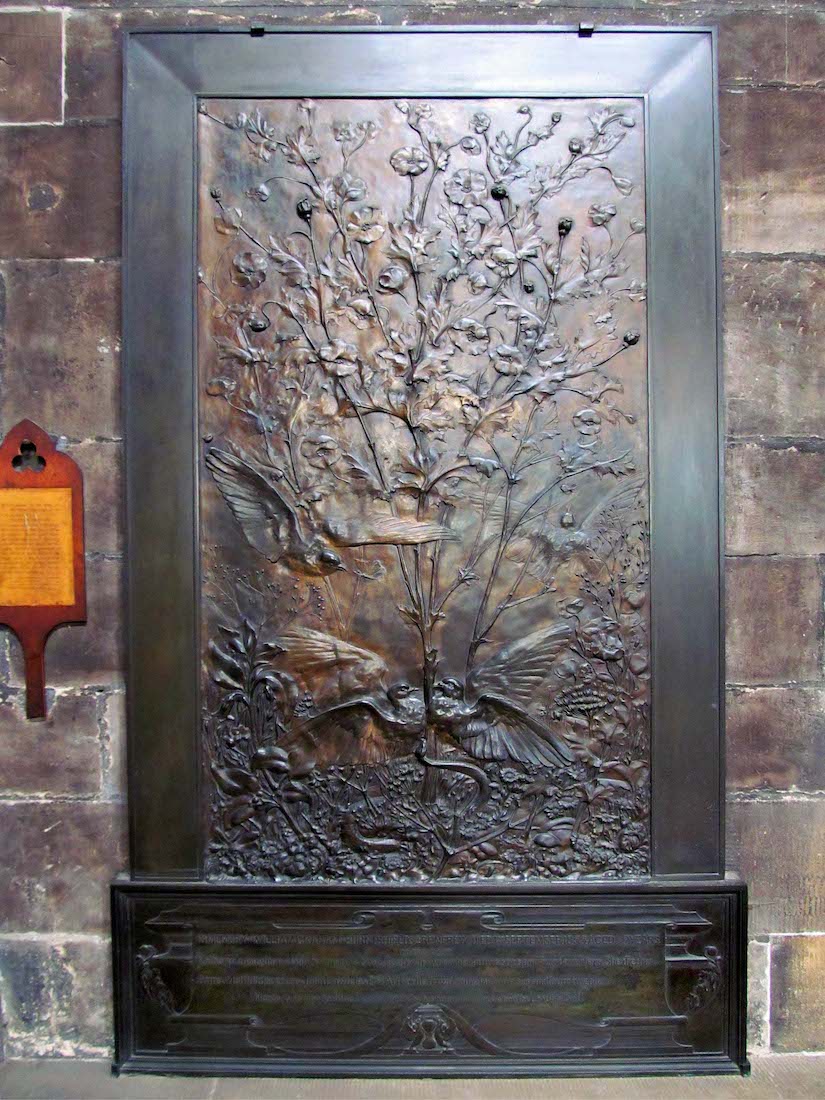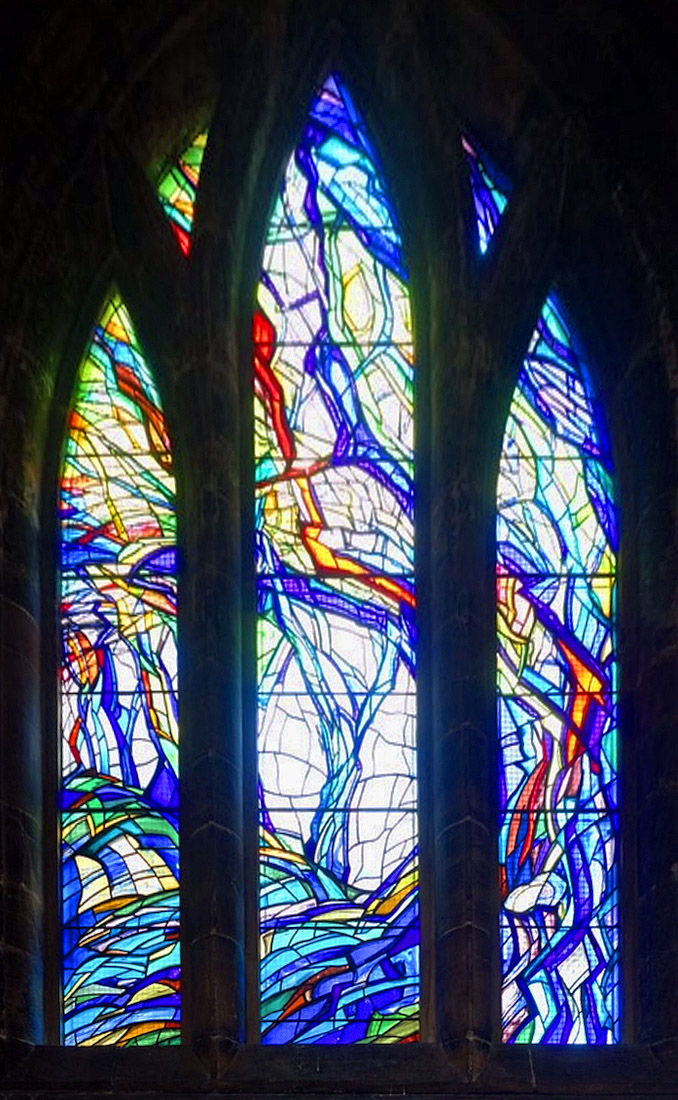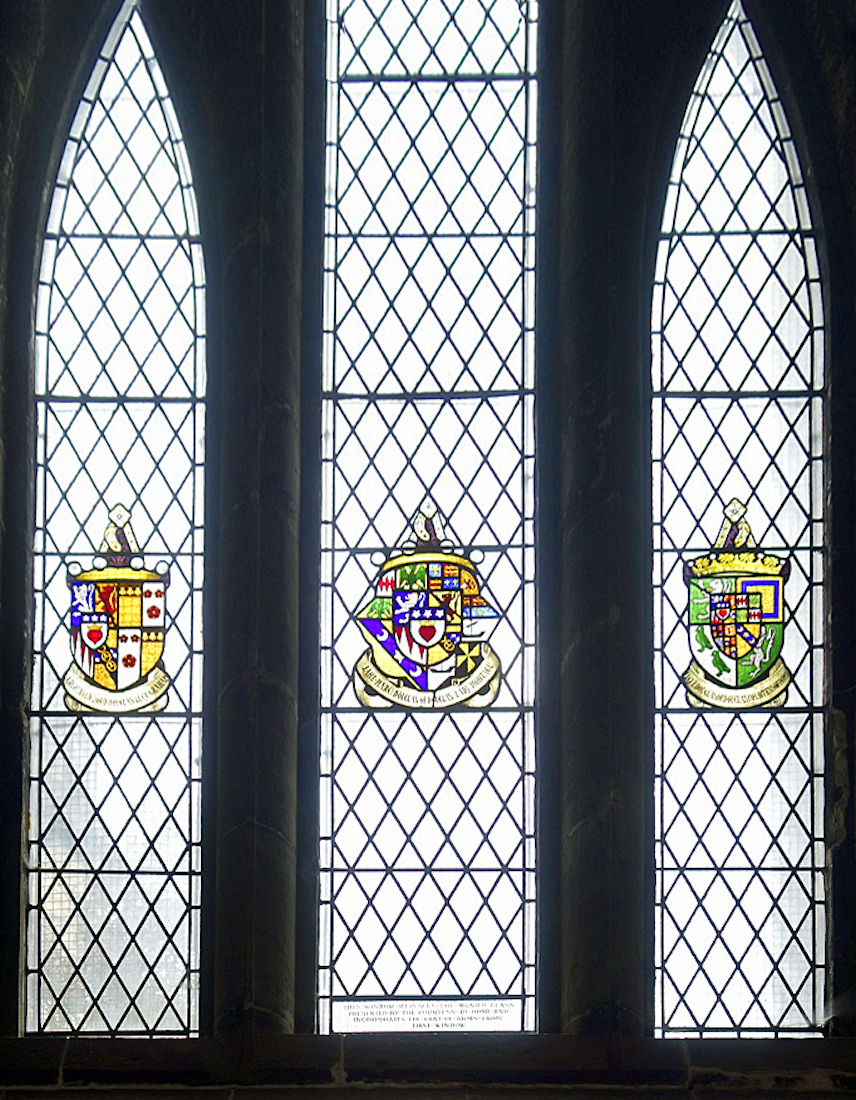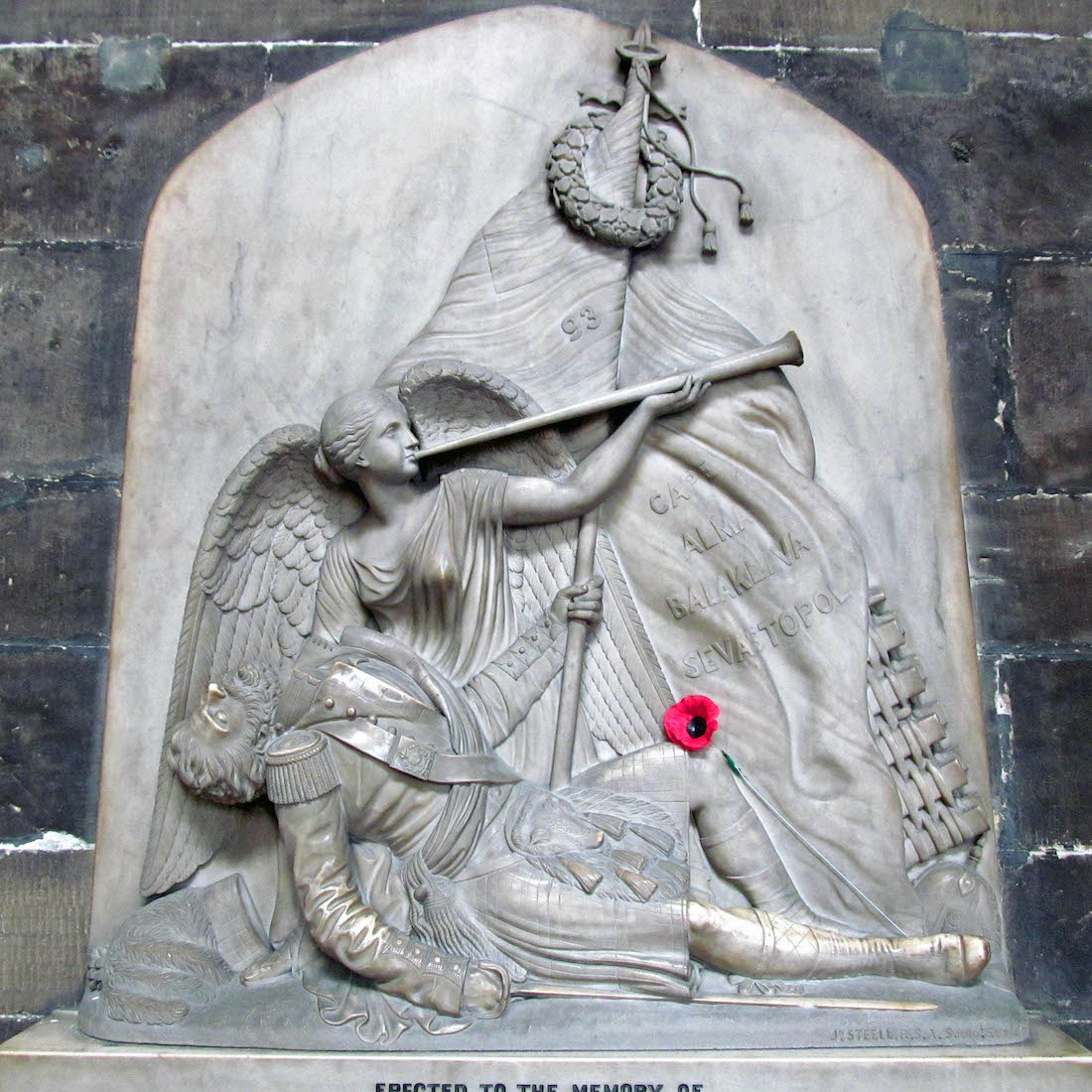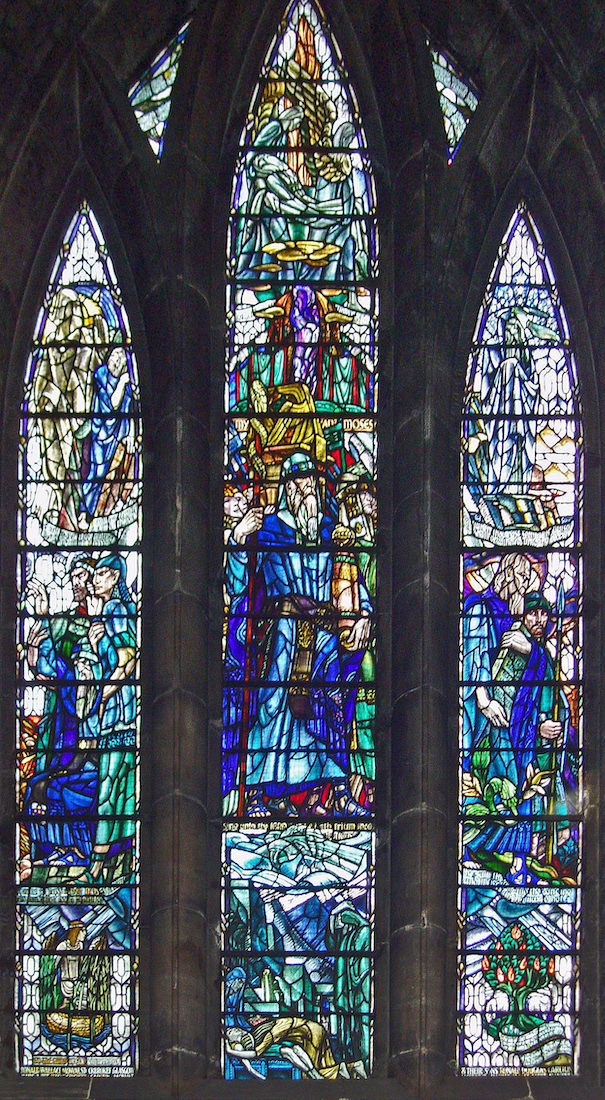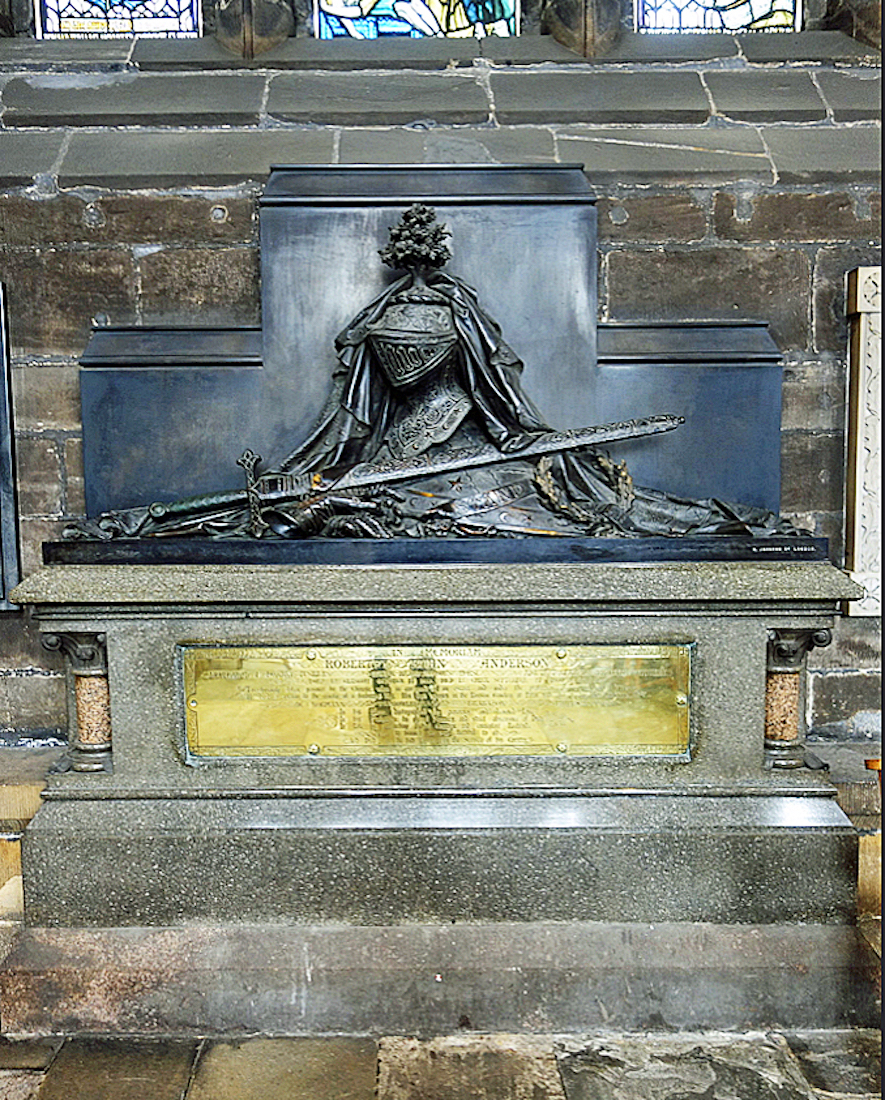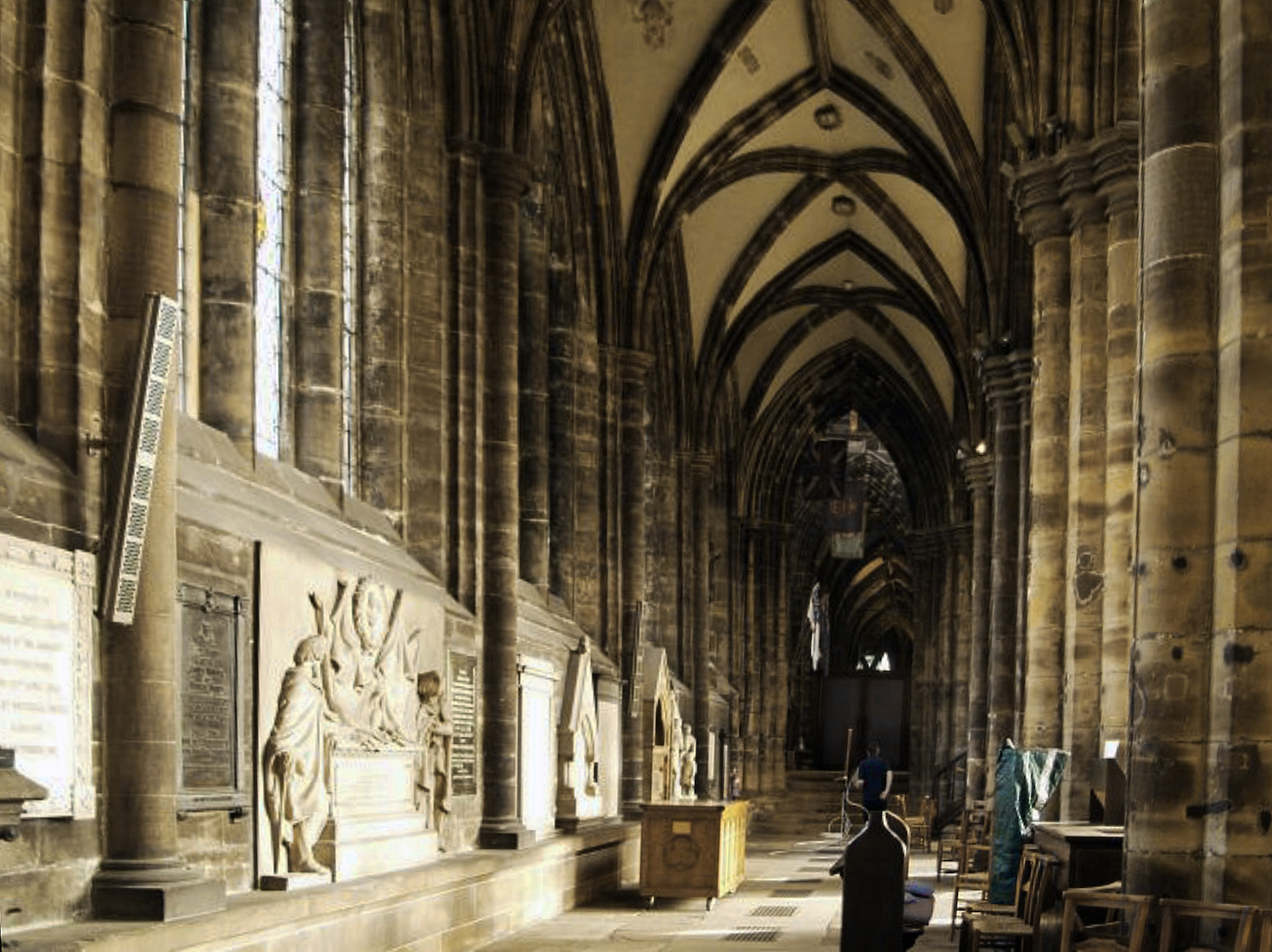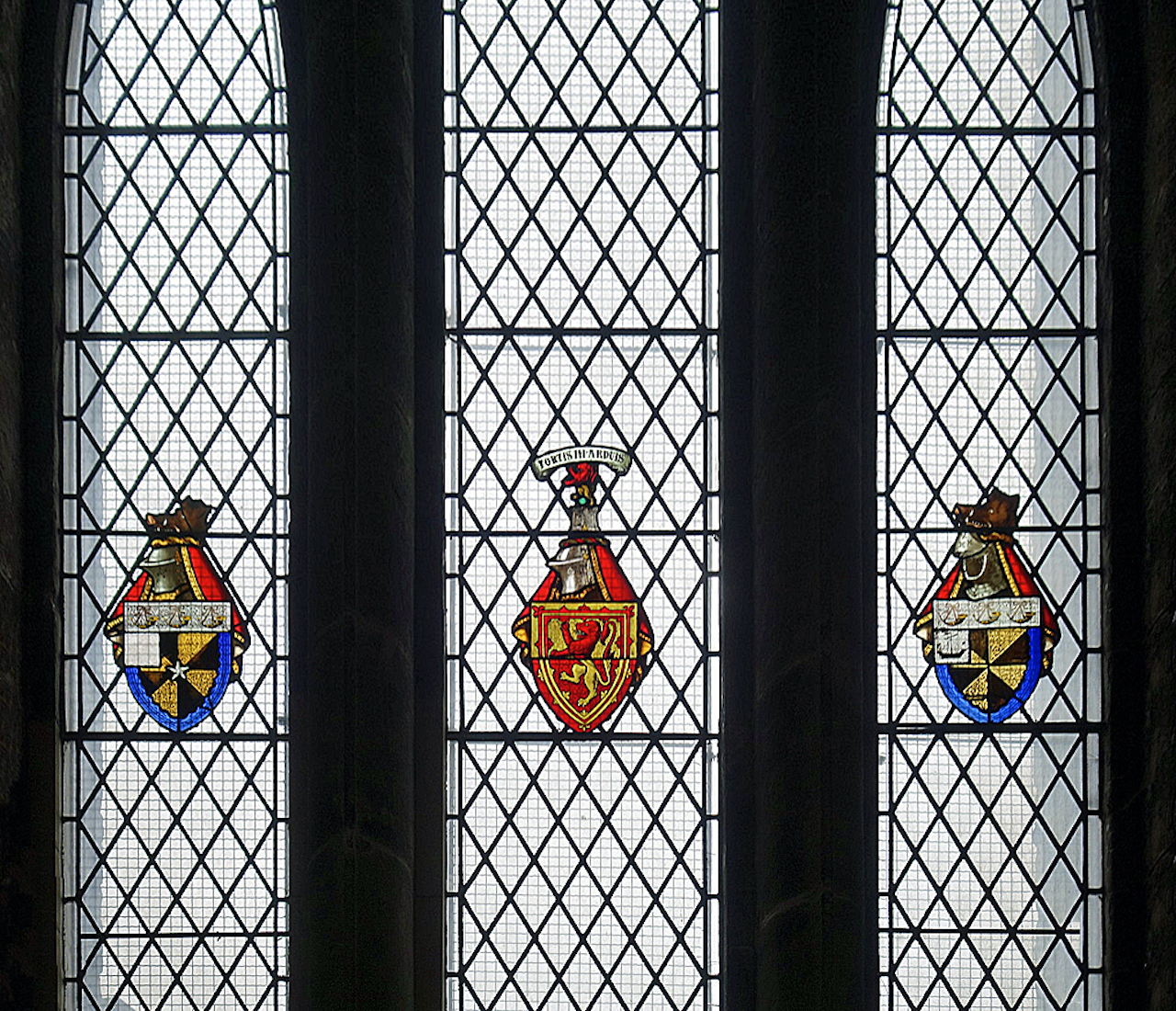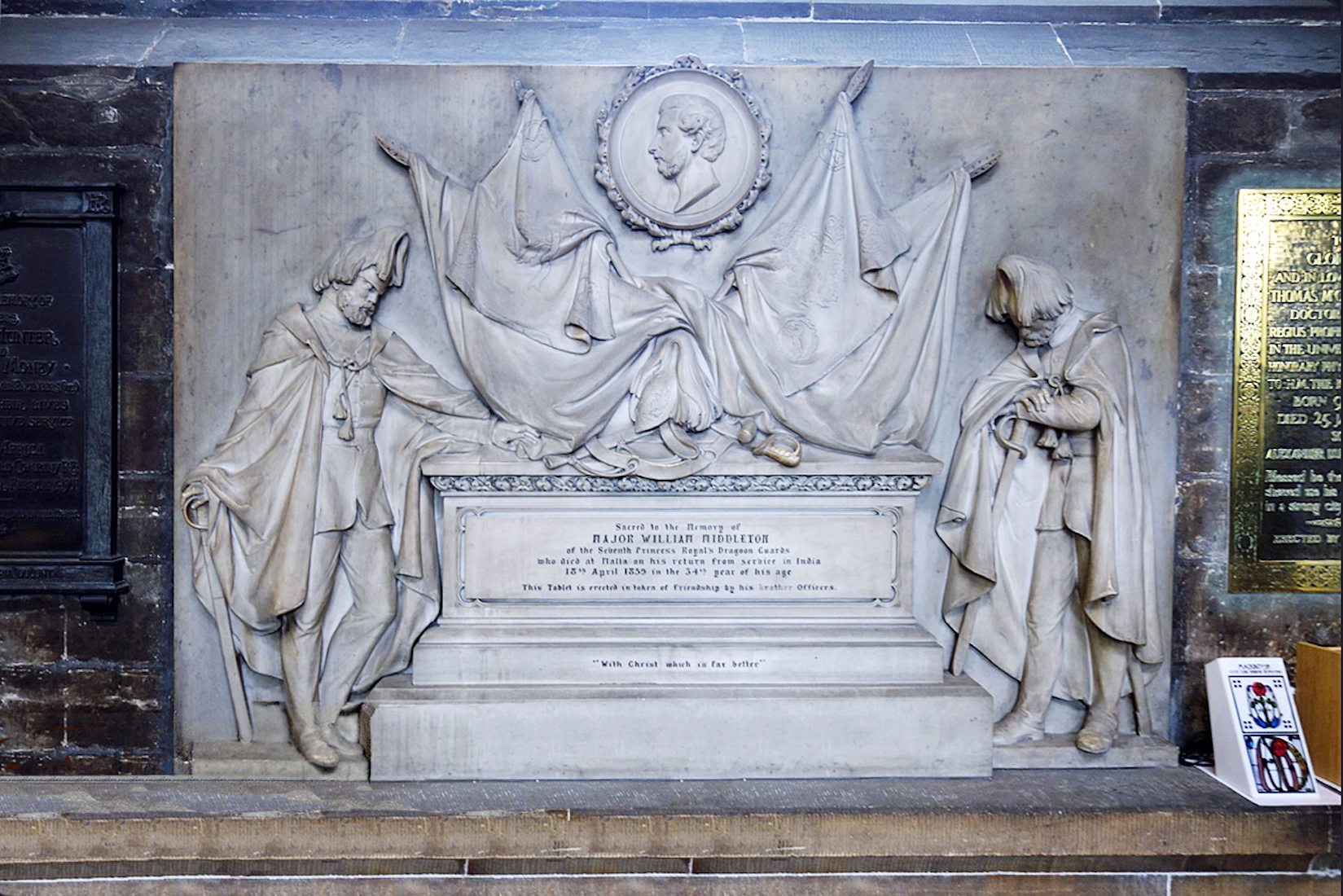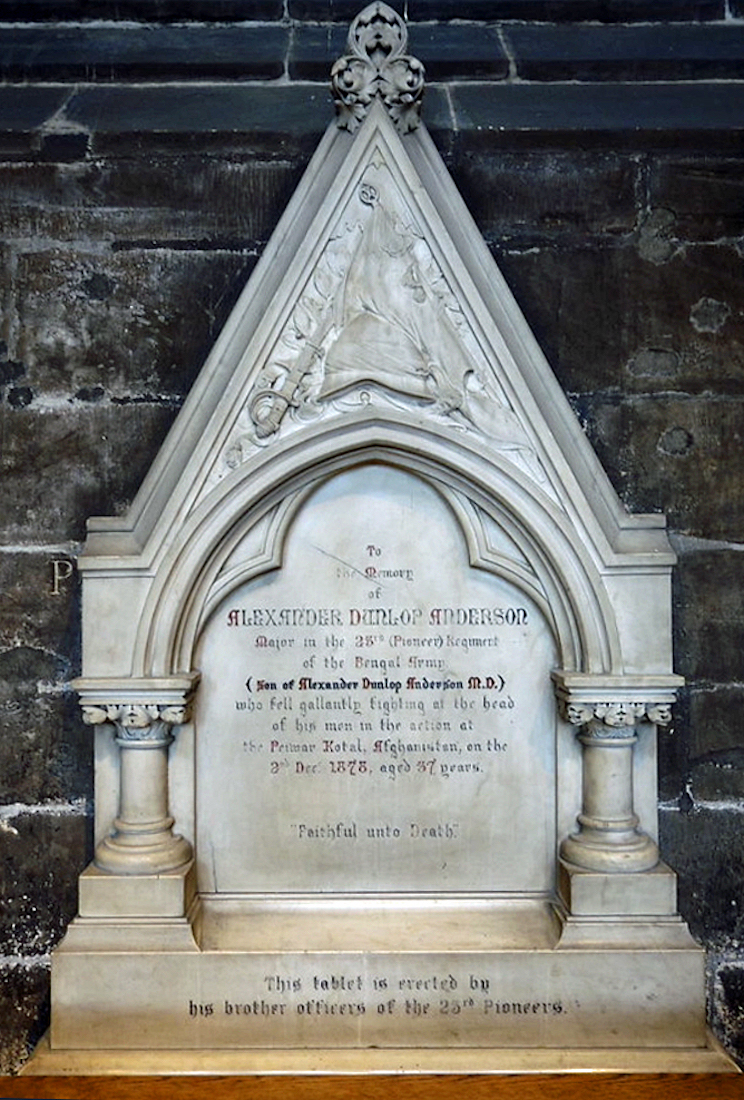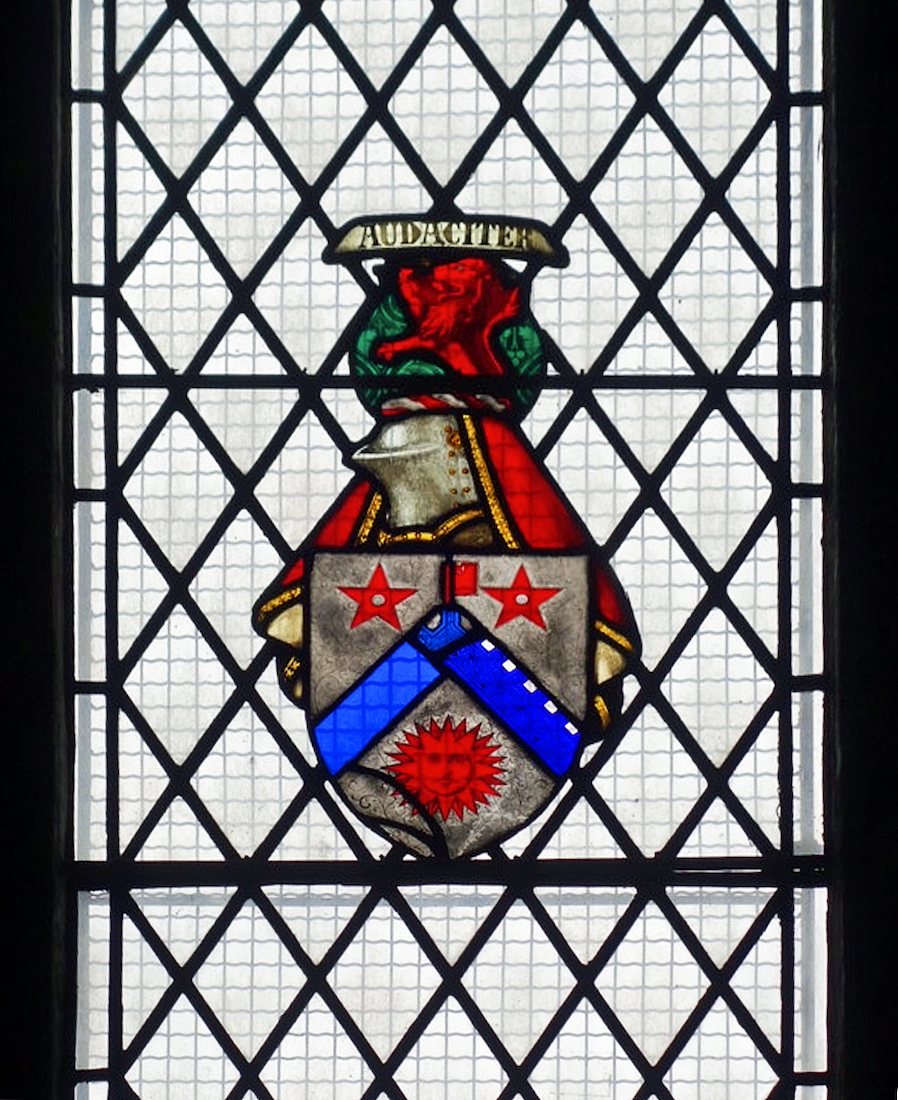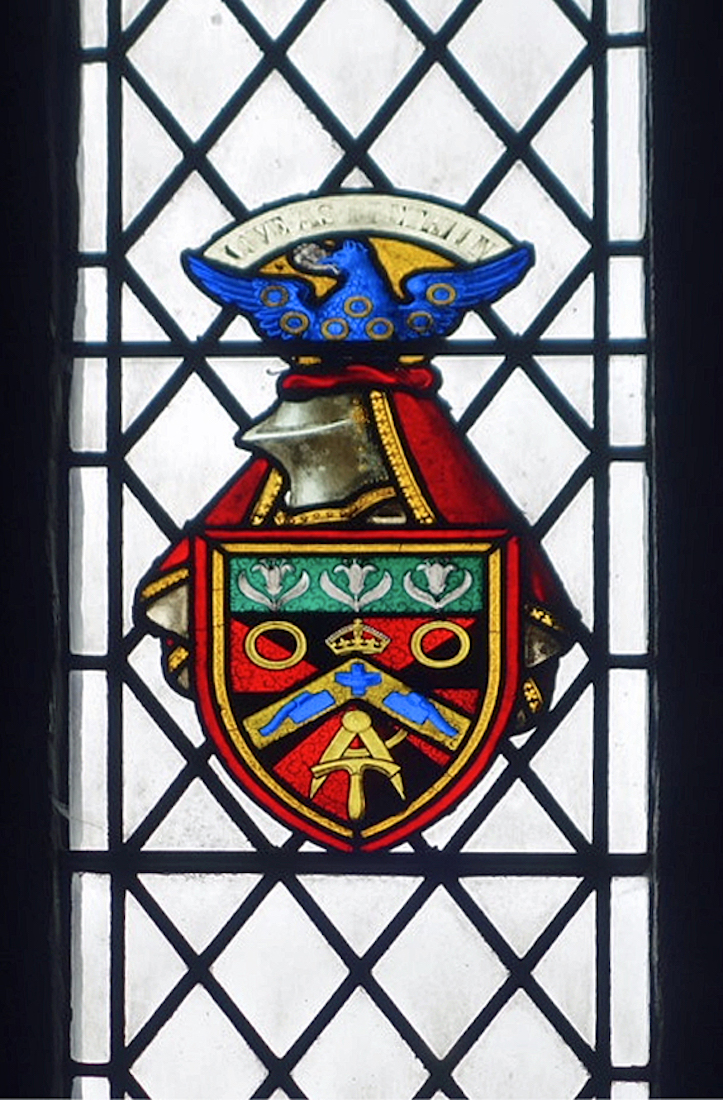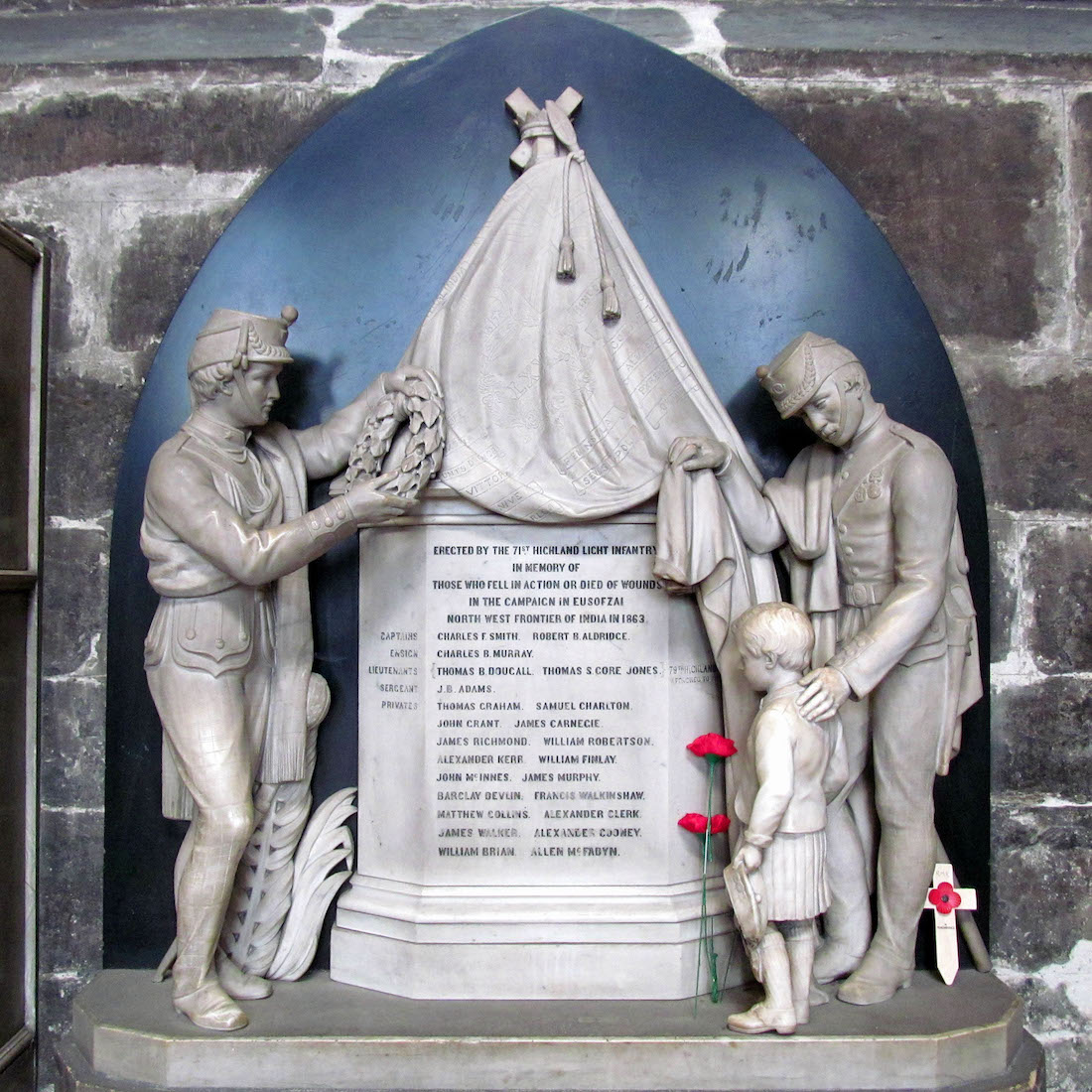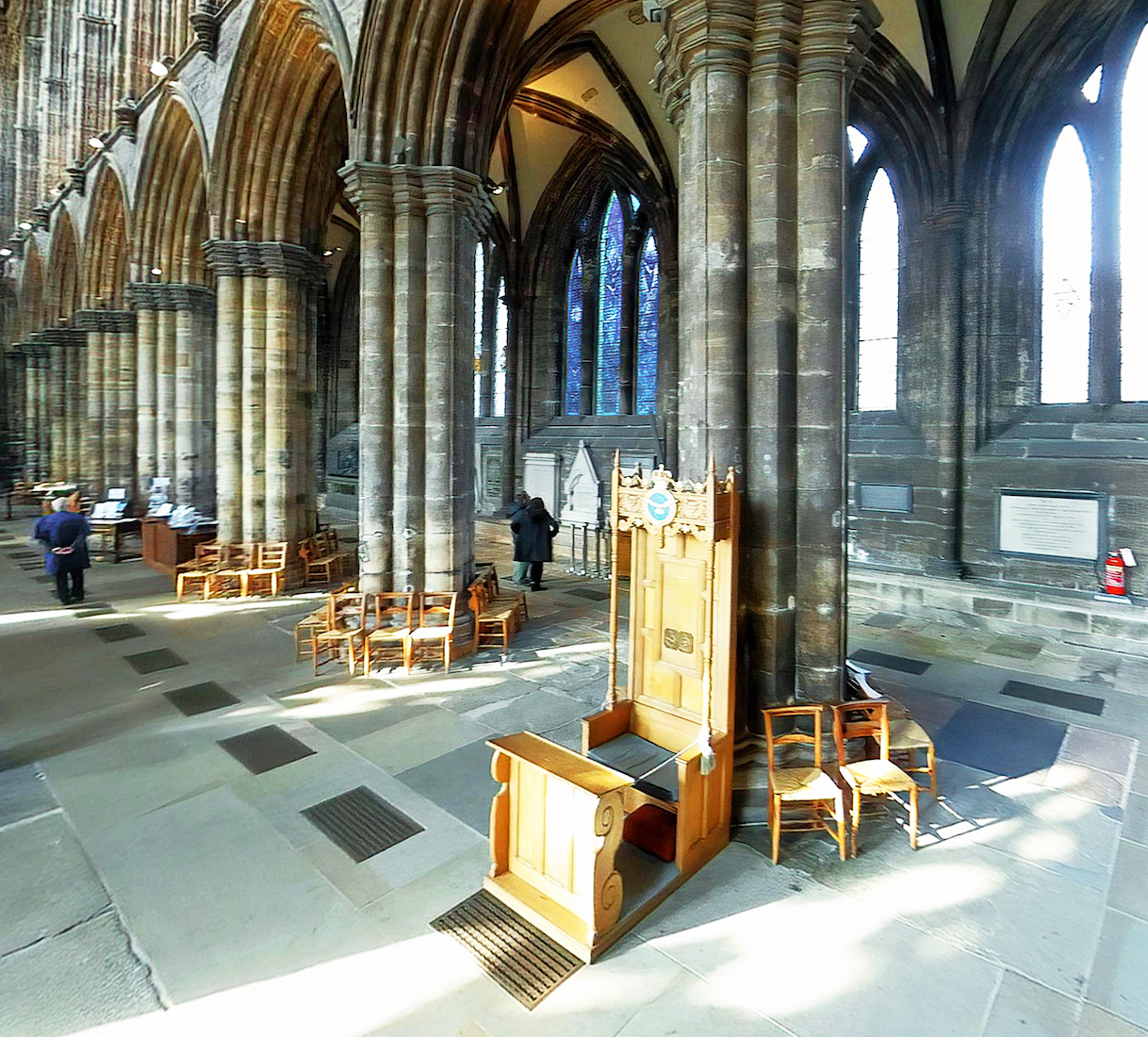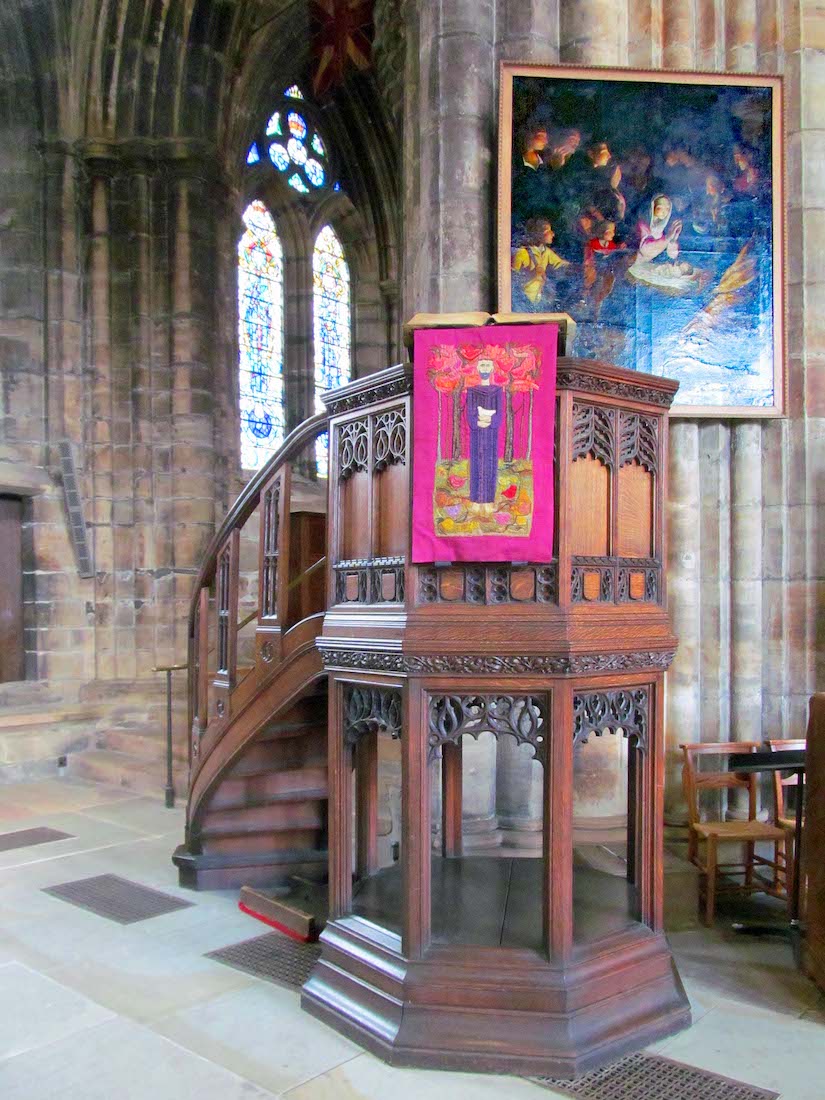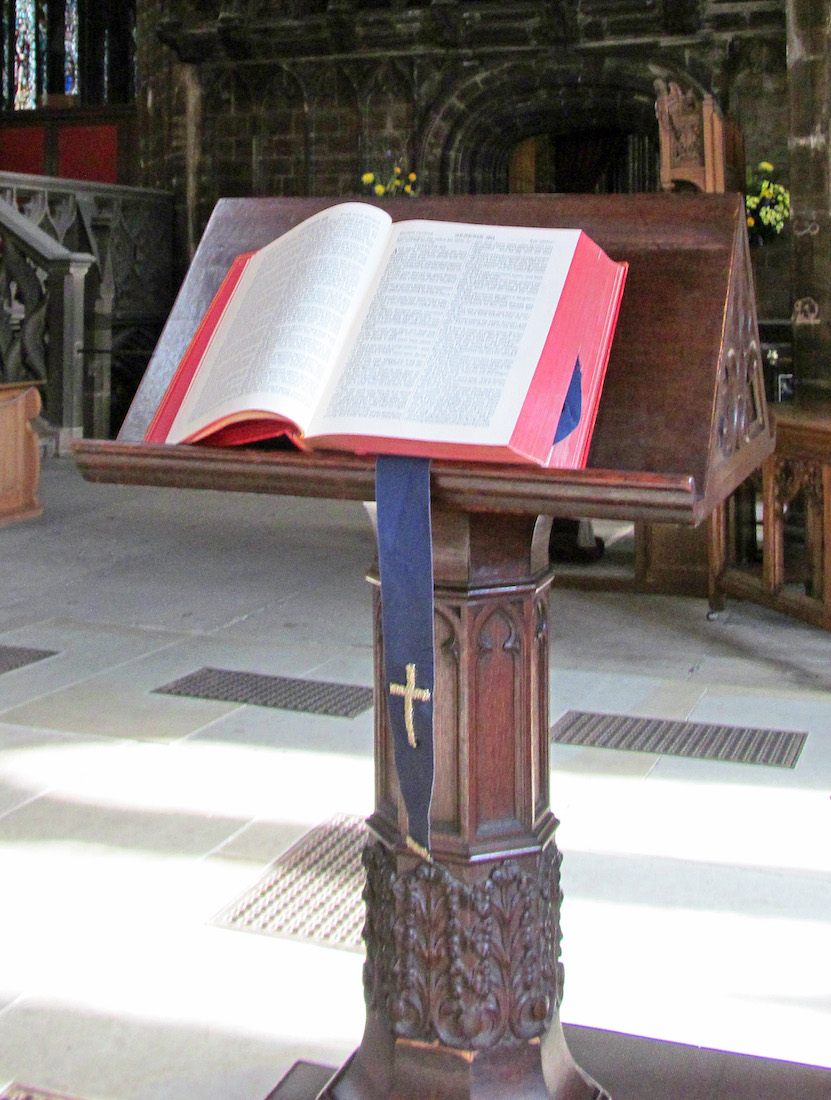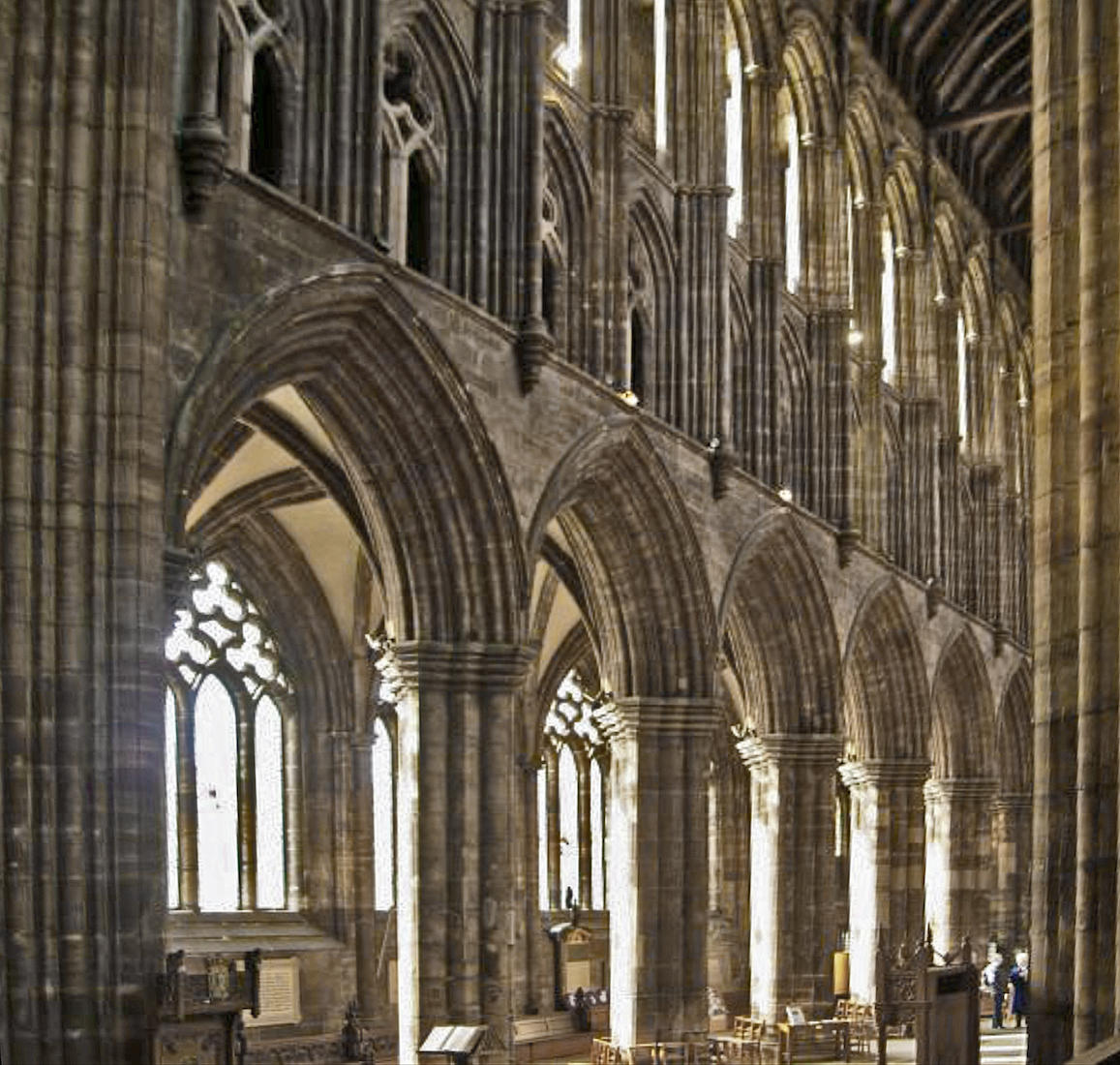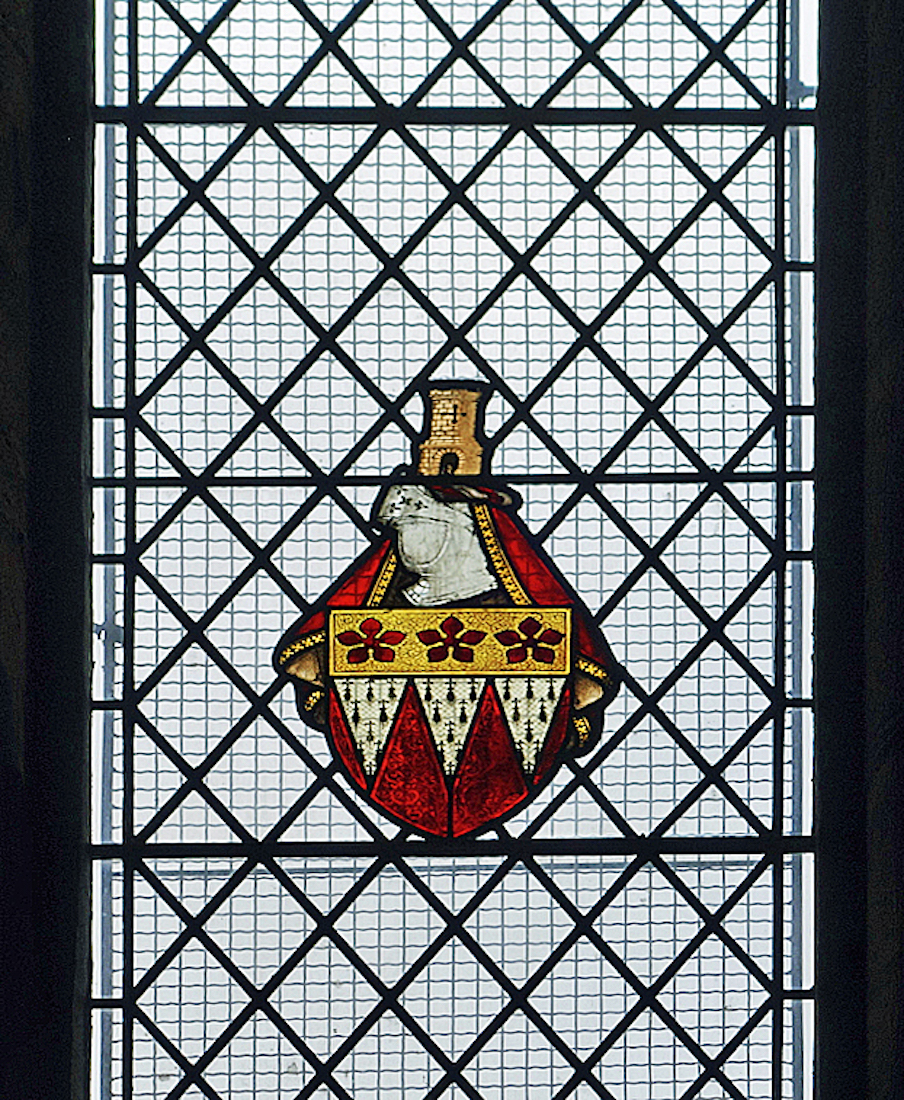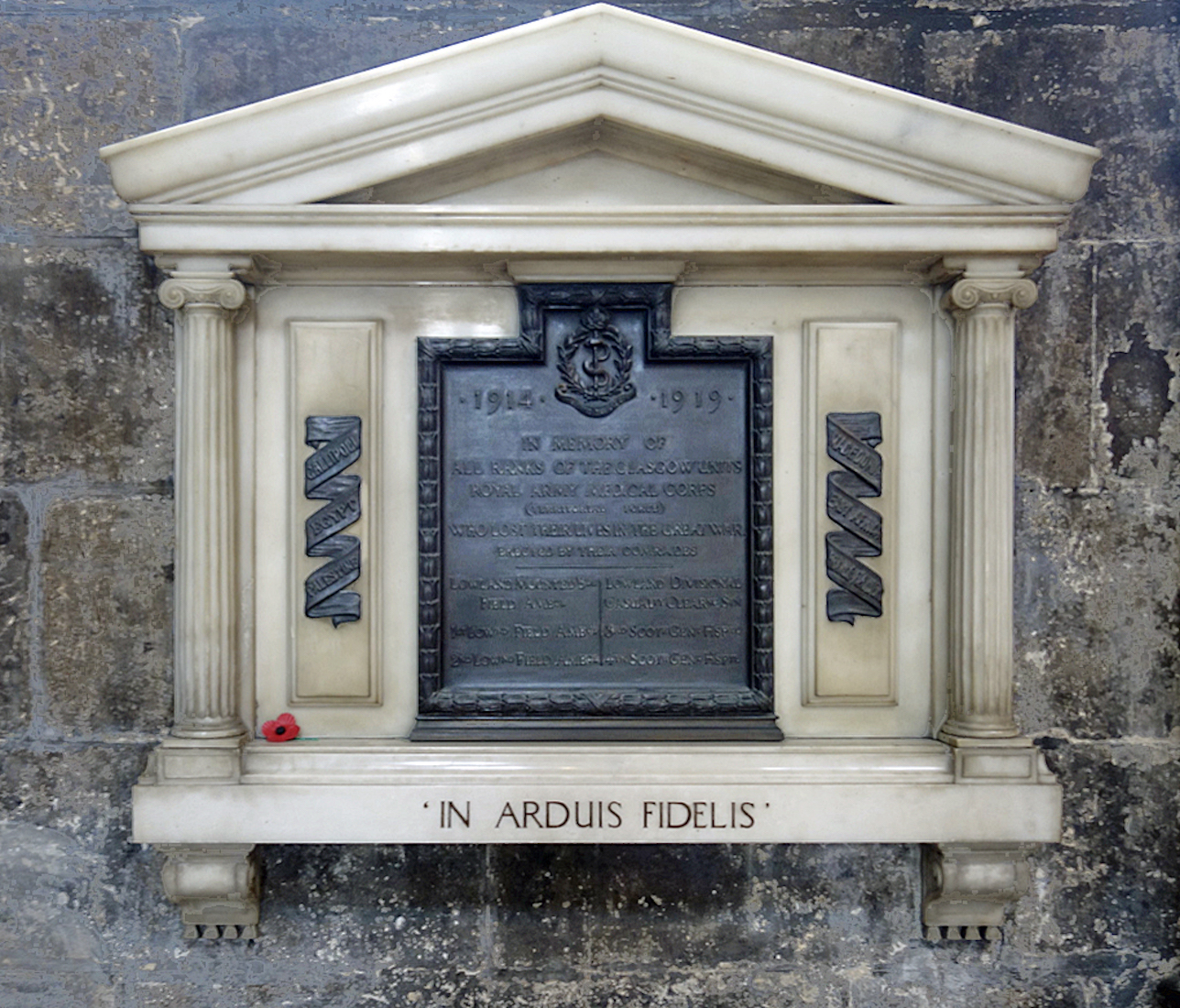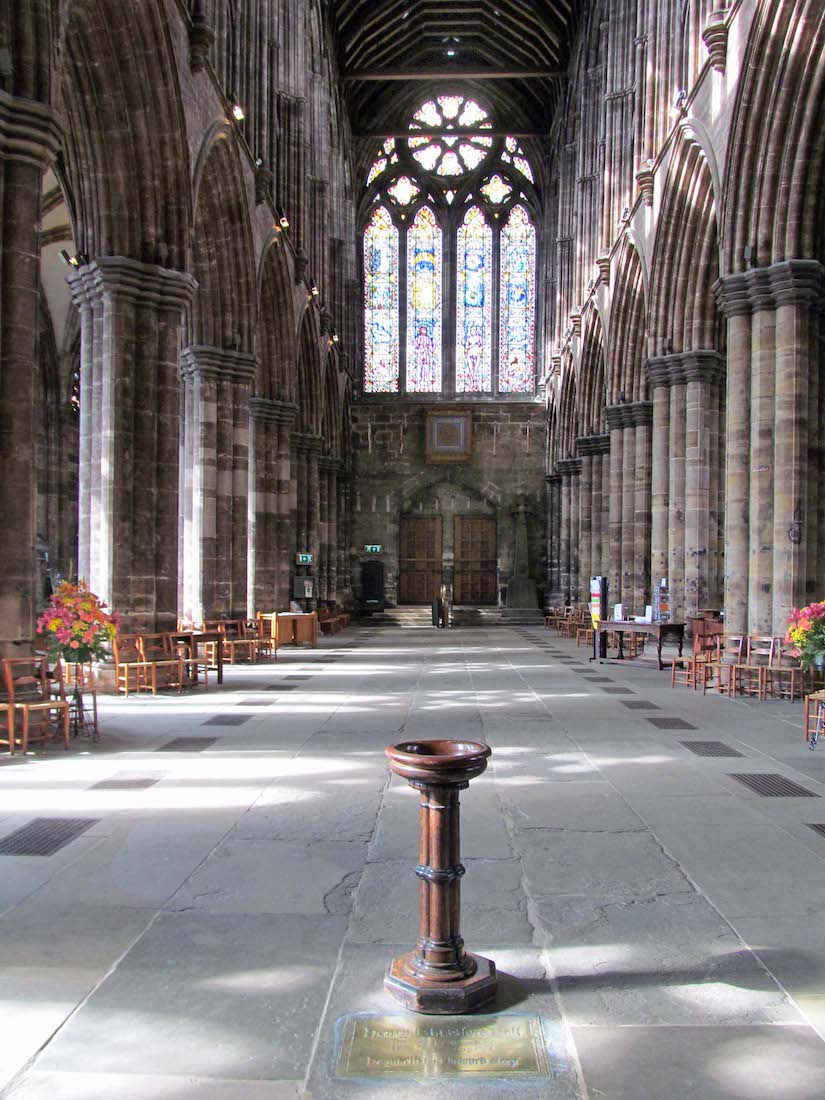
As we look back to the West end of the nave, we observe the Great West Windows, the interesting clock, and the large Celtic cross to the right of the West doors. In the foreground there appears to be a stoup for holy water, but this seems unlikely in this Cathedral! INDEX
N4. GREAT WEST WINDOW AMT

The Great West Window (1958) in the nave of the Cathedral is ‘The Creation’ by Francis Spear. It was the gift of Glasgow Corporation. Reading across the main lights from top left we see day and night, the creation of heaven and earth, the mountains, and the plants and trees. Then follows the creation of sun, moon and stars in the middle band, and at bottom fish and birds on either side of Adam and Eve. The compartments are surrounded by text from Genesis 1, and we see the Lamb of God in the centre of the tracery above. Click here for a zoomed in view.
N5. CLOCK AND CROSS WH IS
The clock below the West window also dates from 1958, and is made of bronze and carved oak. To the left of the doors is a memorial to the 23 battalions of the Highland Light Infantry (HLI), and to the right, a stone cross commemorating the 2nd Battalion.
N6. NORTH WALL Go Go
We are going to explore the nave by following round the walls in a clockwise direction. Each window has one or more memorials below it: of these we pick out the more spectacular! The above photos are not of the best quality, but they do give us an idea of what lies in store. [Photo Credits: Google]
N7. SCOTS GUARDS WINDOW WH IS
The North window on the West wall is the Scots Guards Window by Harry Stammers (1956). Donated by the Regiment, this window was unveiled by the Duke of Gloucester on 14th April 1956. Harry Stammers is a renowned stained glass artist. The Regimental crest is shown at top, and the two figures at the top of the lights hold a sheaf of wheat, a sword, a dove and a cross, symbolising the four freedoms: Freedom from Want, Freedom from Fear, Freedom of Speech, and Freedom of Worship. • Beneath the window is this memorial by Clelands to Lieut. John Stirling of the Bombay Army. Lieutenant John Stirling, eldest son of Glasgow Merchant William Stirling, was a cavalry officer of the Bombay Army who fell, aged 23, while leading the assault against the Fort of Dundhootee on 3rd January 1828. His remains were buried where he fell. The memorial features a scroll inscribed with the phrase `Gang forward!`
N8. BATTLE OF VITTORIA MONUMENT IS IS
The adjacent window on the North wall is the Napier Arms Window. Clan Napier is a Lowland Scottish Clan. Members of this clan have been recognised for their bravery in various Scottish conflicts. • Beneath this window and shown at right is the Hon. Henry Cadogan Memorial. Lieutenant-Colonel Henry Cadogan of the 71st or Glasgow Regiment led his men out of the old Gallowgate Barracks to embark on their way to fight in the Peninsular Wars against Napoleon. He fell at the head of his troops at the Battle of Vittoria, on 21 June 1813, urging his men onward with the cry of ‘Huzza Boys! Doon the Gallowgate wi’ them!’
N9. BELL AND GRAHAM MEMORIAL IS WH
This bell was recast in 1790, but is believed to be one of the bells given by Archbishop Dunbar in the 16th century. It used to hang in a now-demolished bell tower close to here outside the Cathedral. • At right is the Graham Memorial. This is a bronze memorial plaque remembering William Graham, 1874, designed by Sir Alfred Gilbert, R.A. (1854-1934). William Graham (1817 – 1885) was a Liberal MP for Glasgow, a Scottish politician, wine merchant, cotton manufacturer and port shipper. He is remembered as a patron of Pre-Raphaelite artists like Edward Burne-Jones and Dante Gabriel Rossetti and a collector of their works.
N10. TREE OF JESSE WINDOW IS
This Tree of Jesse window is by Emma Butler-Cole Aiken. As a way of visually describing the ancestry of Jesus, the ‘tree of Jesse’ is the subject of many stained glass windows. Most are full of people: Jesse, his son King David, his son Solomon and so on all the way to Jesus, who is often portrayed as a child in the arms of Mary. In this rather more abstract window, this ribbon of red glass represents the redeeming blood of Christ.
N11. CAMPBELL AND LOWE MEMORIALS IS IS
At left is the Lieut. Donald Campbell memorial. Donald Campbell belonged to the 20th Regiment of Foot. He died in Malwan in the East Indies on 26 February 1865, aged 54. • At right is the Memorial to Dr Peter Lowe. Peter Lowe or Low ( c.1550 – 1610) was a surgeon and founder of the institution now known as the Royal College of Physicians and Surgeons of Glasgow.
N12. CRIMEA MONUMENT IS WH
The crests in the window at left belong to members of the Douglas clan. Archibald James Edward Douglas, 1st Baron Douglas (1748 – 1827), was a Scottish politician who married Lady Lucy Graham. • At right is the Crimean War Memorial. Men of the 93rd Sutherland Highlanders, including Major Robert Murray Banner, who fought in the Crimean War are commemorated by this memorial. A fatally wounded kilted soldier is cradled by an angel blowing a horn. The battles in which the Regiment fought during the campaign, namely Cape, Alma, Balaclava and Sevastopol are embossed on the regimental colours held aloft by the dying soldier. The memorial is by Sir John Steel RSA.
N13. MOSES WINDOW AND ANDERSON MEMORIAL IS IS
At left is the Ronald Wallace Mowat Stockbroker window by Douglas Strachan (1875-1950). It is often called the Moses Window, depicting the crossing of the Red Sea. • At right is a memorial to Robert Burn Anderson, Lieutenant of the First Bombay Fusiliers. The plaque on the base reads; `Born in Glasgow 1833, died in China 1860, treacherously taken prisoner by the Chinese when in command of an escort and under protection of a flag of truce, he died a victim to the cruelty of a barbarous foe`. Anderson was captured along with four others and, with their hands tightly bound, they were left under the scorching sun for three days without food or water. None survived the ordeal.
N14. NORTH AISLE PB
Here is the remainder of the North aisle. The corner of the Anderson Monument is just visible at left.
N15. MIDDLETON MEMORIAL IS IS
The window at left has three coats of arms. The central one with motto ‘Fortis in Arduis’ (= Strong in Difficulties) belongs to the Earl of Middleton. The arms on either side belong to the Campbells of Stracathro. • At right is the Major William Middleton Memorial by Mossman. Major William Middleton of the Seventh Princess Royal’s Dragoon Guards died in Malta in 1859, aged 34, on his way back to the United Kingdom having been serving in India.
N16. MILLENIUM WINDOW WH IS
‘The Millennium Window on the North wall of the nave was unveiled on 3rd June, 1999 by H.R.H. The Princess Royal. The glass painter selected was Mr. John K. Clark who was a student and then lecturer at The Glasgow School of Art. His studio is in Germany. Progress was carefully monitored by Historic Scotland. The theme that was agreed with the Donors was GROWTH. As the project was mainly funded by three Glasgow schools this is a highly appropriate theme.’ [Cathedral website] The windows are full of text from Scripture – mostly from the parable of the sower, but difficult to read. • The Monument at right remembers Alexander Dunlop Anderson.
N17. WINDOW IS IS
The next window along the north wall has two coats of arms. The one on the left is associated with Clan Ewing. The motto ‘Audaciter’ translates to boldness, audacity. This is a Highland clan which was historically based both in Dumbartonshire & Stirlingshire in the Lennox, and also in Cowal in Argyll, and which claims descent from Clan Ewen of Otter. • The crest on the right belongs to the Worshipful Company of Coopers. The motto is ‘Love as Brethren’.
N18. HEDDERWICK MEMORIALS IS WH
Below the window are these two memorials. At left is the memorial to James Hedderwick LLD 1814 –1897 by James Pittendrigh Macgillivray erected in 1901. Hedderwick was a Scottish poet, journalist and newspaper proprietor. He was the founder of the Glasgow newspaper, the Evening Citizen. • At right is the 71st Highland Light Infantry Memorial by William Brodie. This is a memorial to the men of the 71st Highland Light Infantry who fell in action or died of wounds during the Eusofzai campaign in the Northwest Frontier of India in 1863. A list of casualties follows.
N19. NORTH WALL Go
We have now reached the East end of the North nave wall. Shown here is one of two moveable seats used by service celebrants. [Photo Credit: Google]
N20. PULPIT AND LECTERN WH WH
At the front of the nave we come to the nicely carved wooden pulpit and lectern. The lectern is one of the two-sided variety, with a Bible support front and back. Above the pulpit is an Italian painting. It is a studio copy of ‘The Adoration of the Shepherds’ by Camillo Procacini (1546 – 1625). The original is in the Brera Gallery in Milan. The pulpit has a ‘fall’ (banner) for each Church season. This purple one for Advent and Lent depicts St Francis, and is the work of Mrs Veronica Togneri. The stained glass window seen here behind the pulpit is sited in the North transept; we shall return to this in due course. The wooden door in the wall behind the pulpit, seen at left, is not open to the public. It leads to a spiral staircase up to the triforium and roof.
N21. VIEW TO SOUTH AISLE PB
We now move to the South aisle where there are further windows and monuments. The Eastern-most window on this wall cannot be seen here – it is behind the column at left.
N22. MEDICAL CORPS MONUMENT IS IS
The coat of arms in the first window, depicted at left, is unknown to me. • The memorial at right commemorates the 1914-1919 Glasgow Units of the Royal Army Medical Corps First World War. The motto is ‘In Arduis Fedelis’ or ’Faithful in adversity’.


